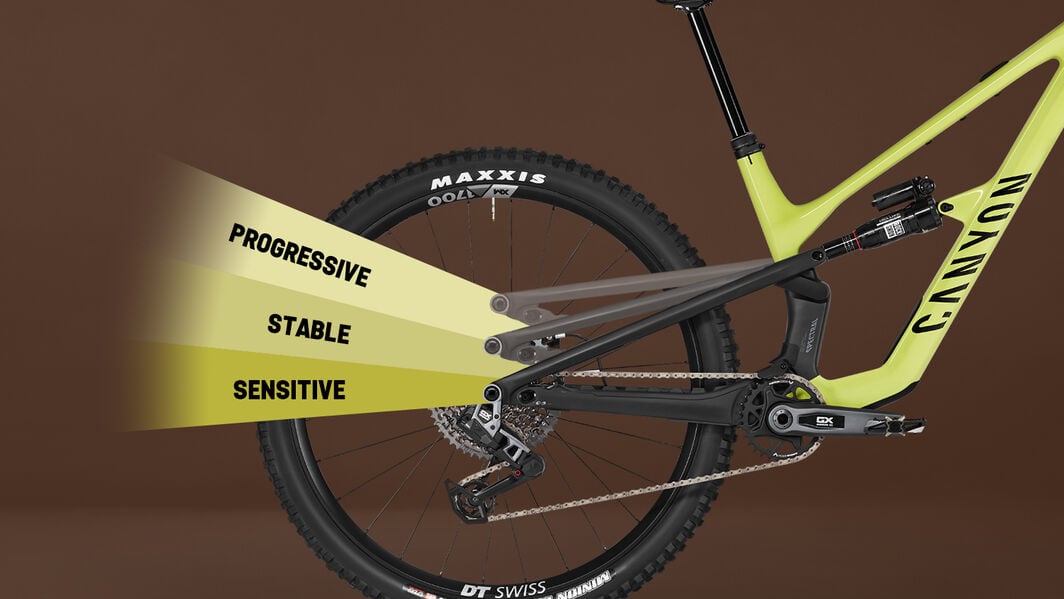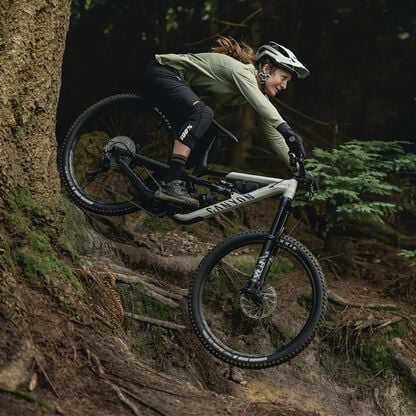Spectral o Strive: qual è la migliore per te?
Spectral o Strive? Anche se queste bici potrebbero non sembrare troppo diverse a prima vista, sono in realtà molto diverse, progettate per missioni molto diverse: si tratta di dettagli. Questa breve guida ti aiuterà a decidere quale sia quella che fa per te.


"Una bici da gara per l’enduro e una bici da trail aggressiva, per divertirsi." Ecco come il due volte Campione del Mondo di DH Fabien Barel spiega le differenze tra la Spectral e la Strive. “Qual è la differenza tra una bici da trail e una da enduro?” questa è una delle domande più frequenti nella mountain bike. La bici da enduro Canyon Strive e la bici da trail Spectral rappresentano i due lati di questa moneta. Anche se su carta queste bici potrebbero sembrare abbastanza simili, sono progettate per rider molto diversi.
Indice
Comprendere la geometria: Differenze tra Spectral e Strive
La geometria si basa sulla connessione del rider con la bicicletta e con il percorso, quindi, sebbene ci siano alcune piccole differenze, sono meno numerose di quanto ci si possa aspettare e il livello di esperienza del ciclista ha un impatto maggiore rispetto al modo in cui la bici verrà guidata. Dal momento che entrambe le mountain bike sono destinate a rider esperti, condividono molti degli stessi valori di geometria. I punti cardine della filosofia Canyon sono il reach lungo e il movimento centrale basso, che sono identici su entrambe le bici. Anche stack, angolo sterzo e angolo sella sono abbastanza simili su entrambe le bici. Ci sono alcune piccole differenze: la Spectral ha foderi leggermente più lunghi nella versione 29er, ma leggermente più corti nella configurazione mullet (ruota posteriore da 27.5”). In generale, chi sceglie la Spectral da 29” cerca di percorrere il terreno nel modo più efficace, mentre chi preferisce la mullet vuole una bici che sia la più agile possibile da manovrare e questa differenza si riflette nella lunghezza dei foderi orizzontali.
Dinamica delle sospensioni: Differenze tra Strive e Spectral
È nella sospensione che puoi trovare le differenze maggiori tra queste due bici. In poche parole, la Strive ha più escursione grazie a una forcella da 170 mm e all’ammortizzatore da 160 mm. La Spectral in fibra di carbonio ha una forcella da 150 mm e una escursione posteriore di 140 mm, mentre la versione in alluminio ha una forcella da 160 mm e una escursione posteriore di 150 mm. "Quando si ha una corsa anteriore leggermente più lunga rispetto a quella posteriore, come sulla Spectral, e ancora di più con la Strive, questo imposta il sag dinamico in base all’utilizzo," spiega Barel "Per le nostre bici progettate per ciclisti più esperti, come la Strive e la Spectral, questo sag dinamico mette il baricentro verso la parte posteriore perché normalmente si percorrono trail più ripidi rispetto ai ciclisti meno esperti."
"La Spectral può essere configurata per essere efficiente nelle gare, ma è soprattutto una bici eccellente per saltare, per avere una buona velocità e giocare sui sentieri," continua Barel. "La Spectral è la bici più progressiva, mentre il cinematismo della Strive ha una piattaforma a metà corsa che consente di mantenere la velocità. La Strive è molto morbida all'inizio, con un buon sostegno a metà corsa e poi molto progressiva nell'ultimo terzo dell'escursione, proprio per evitare il bottom out."

Il design dei telai a confronto
Essendo una bici da gara, la Strive è disponibile solo in fibra di carbonio. Le mountain bike in carbonio sono più leggere e più adattabili per permetterti di andare il più veloce possibile. Progettata per una gamma più ampia di rider e stili di guida, la Spectral è disponibile sia in carbonio che in alluminio. Le mountain bike in alluminio sono un po’ più pesanti e non condividono alcune tecnologie, ma ciò significa che sono più convenienti e rappresentano l’opzione migliore per tutti quei rider che danno priorità al budget piuttosto che alle prestazioni.
L'intensità con cui si intende utilizzare la bicicletta potrebbe essere un fattore decisivo. La Spectral è conforme alla categoria 4 ASTM. Questo significa che è progettata per la guida aggressiva, forse anche per un po’ di bike park, ma se vai su trail davvero estremi stai spingendo la bici oltre ciò per cui è stata progettata. Avendo la classificazione ASTM di categoria 5 significa che la Strive può affrontare lo stesso tipo di trail che faresti con una bici da downhill o da freeride: è progettata per i trail più difficili che puoi trovare. Questa differenza significa anche che la Spectral sarà sempre un po’ più leggera della Strive, poiché una guida meno estrema richiede meno rinforzi sul telaio.
Panoramica sulla tecnologia: Innovazioni Spectral vs Strive
Puoi vedere la differenza di intenti di queste due bici controllando la tecnologia impiegata su ogni modello. La Strive è completamente incentrata sulle gare. La tecnologia Shapeshifter trasforma una bici progettata per la velocità in discesa in un’efficiente scalatrice con un semplice movimento di una levetta. Questo dà priorità all’efficienza della pedalata rispetto all’esperienza di guida, riducendo la corsa, accorciando l’interasse e sollevando il movimento centrale, perché in una gara di enduro la salita non è la parte divertente della pedalata, ma è ciò che bisogna percorre per arrivare alla discesa successiva! Inoltre, è possibile scegliere tra due calotte della serie sterzo, in modo da poter regolare con precisione la vestibilità e la maneggevolezza della bicicletta. Una calotta offre una regolazione dell'angolo di sterzo di 0,5 gradi e l'altra una regolazione del reach di +/- 5 mm, questo assicura una gamma di opzioni per impostare la bicicletta in base alle proprie esigenze.
La versione in fibra di carbonio della Spectral è dotata dell’innovativo sistema K.I.S. per mantenere lo sterzo più stabile e aiutare a divertirsi al massimo sui trail. Nel telaio è presente un vano portaoggetti nel tubo obliquo, per portare con sé alcune parti di ricambio, attrezzi o cibo per stare più a lungo fuori. Include anche un flip chip che consente di sollevare il movimento centrale di 8 mm e di aumentare l’angolo di sterzo di 0,5°, per i ciclisti che cercano una bici da trail più neutrale. Le versioni in alluminio della bici non condividono queste stesse caratteristiche, perché la fibra di carbonio consente una maggiore complessità per alloggiarle.

Componenti a confronto: Specifiche Spectral vs Strive
Entrambe le bici condividono assemblaggi molto simili, con manubrio e attacco manubrio G5 di Canyon, un lungo reggisella telescopico, sospensioni capaci e pneumatici Maxxis Exo+ aderenti che rendono le bici pronte all’azione fin da subito. Approfondendo i componenti, si può notare come la Strive sia molto più specifica. Ogni modello Strive è dotato di ruote da gara, progettate per sopravvivere ai rigori delle gare di enduro e altro ancora. Per la Spectral, i set ruote sono un po’ più leggeri e sono offerti a prezzi più bassi perché la guida sui trail è solitamente meno dura per le ruote.
La storia è simile per quanto riguarda le sospensioni: ogni Strive è dotata di sospensioni di alta gamma con regolazioni che la preparano per qualsiasi trail si debba affrontare. Questo ha un prezzo, quindi per rendere la Spectral disponibile a più rider viene offerta con sospensioni leggermente meno robuste e meno regolabili come la forcella più leggera Fox 36 e la RockShox Lyrik, piuttosto che la più robusta Fox 38 o Zeb.
Come prendere una decisione?
Essendo parte fondamentale del team di sviluppo di entrambe le bici, Barel lo dice in modo molto sintetico: "La Strive è in grado di assorbire i grandi colpi, offre la massima aderenza e ha un telaio con le stesse norme di una bici da DH, per cui si può usare anche in bike park. Puoi affrontare i trail e le asperità come avessi una mini bici da downhill. La Spectral è una bici esuberante, impegnativa. È per i rider professionisti che preferiscono il divertimento alla velocità."
Lo Spectral è più che all'altezza di una gara occasionale di enduro, ma se si tratta di un'attività che si svolge ogni fine settimana, la Strive è la scelta più naturale. Se stai pedalando con gli amici o semplicemente esplorando i trail, la Spectral è probabilmente la soluzione migliore per te. Se il budget è il fattore che per te è decisivo, la Spectral è disponibile in versioni più economiche.

Scopri le nostre mountain bike
Questo articolo ti è stato d’aiuto?
Grazie per il tuo feedback
-
 Informazioni sull'autore
Informazioni sull'autoreMatt Wragg
Matt Wragg è un fotografo freelance, scrittore e rompi-bici che vive nei pressi di Nizza Francia. Dopo aver preso la sua prima mountain bike a 14 anni, Matt è rimasto stregato. Sono seguiti periodi di scarso successo nelle gare di XC, trial, 4X e DH. Dopo essersi laureato in inglese presso l’Università di Birmingham nel 2004, ha svolto la sua professione come consulente per le comunicazioni a Birmingham, e successivamente a Londra.
















